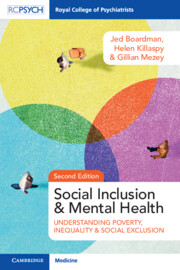Book contents
- Social Inclusion and Mental Health
- Reviews
- Social Inclusion and Mental Health
- Copyright page
- Contents
- Foreword to Second Edition
- Foreword to First Edition (2010)
- Preface
- Acknowledgements
- Chapter 1 Introduction: Poor, Excluded, and Unequal
- Section 1 Social Exclusion, Poverty, and Inequality
- Section 2 Participation of People with Mental Health Conditions
- Section 3 Including People
- Chapter 17 Enabling Social Inclusion for People with Mental Health Conditions: The Role of Mental Health Services
- Chapter 18 Theory into Practice
- Chapter 19 Broadening an Inclusive Approach
- Index
- References
Chapter 19 - Broadening an Inclusive Approach
from Section 3 - Including People
Published online by Cambridge University Press: 24 November 2022
- Social Inclusion and Mental Health
- Reviews
- Social Inclusion and Mental Health
- Copyright page
- Contents
- Foreword to Second Edition
- Foreword to First Edition (2010)
- Preface
- Acknowledgements
- Chapter 1 Introduction: Poor, Excluded, and Unequal
- Section 1 Social Exclusion, Poverty, and Inequality
- Section 2 Participation of People with Mental Health Conditions
- Section 3 Including People
- Chapter 17 Enabling Social Inclusion for People with Mental Health Conditions: The Role of Mental Health Services
- Chapter 18 Theory into Practice
- Chapter 19 Broadening an Inclusive Approach
- Index
- References
Summary
In addition to adopting greater person-centred and recovery-oriented approach to build more productive partnerships between mental health staff and service users, mental health organisations that wish to become more socially inclusive need to develop partnerships with other agencies, particularly those that provide supported accommodation, supported education, and supported employment, so that these become more of a focus for care planning alongside traditional mental health interventions. Working in partnership to build bridges with local community resources and build capacity for the inclusion of people with mental health conditions acts to break down the stigma and discrimination that they experience. Services also need to ensure that people have access to personal budgets so that they are empowered to direct their own care and support. These approaches bring obvious benefits for carers too since creating a network of services and resources in the community for people will increase the social supports available and potentially reduce carer burden. Clinicians may also experience greater shared responsibility with other providers as they expand their community resource networks and are further rewarded by witnessing people building successful and participatory lives in the community.
Keywords
- Type
- Chapter
- Information
- Social Inclusion and Mental HealthUnderstanding Poverty, Inequality and Social Exclusion, pp. 374 - 386Publisher: Cambridge University PressPrint publication year: 2022



